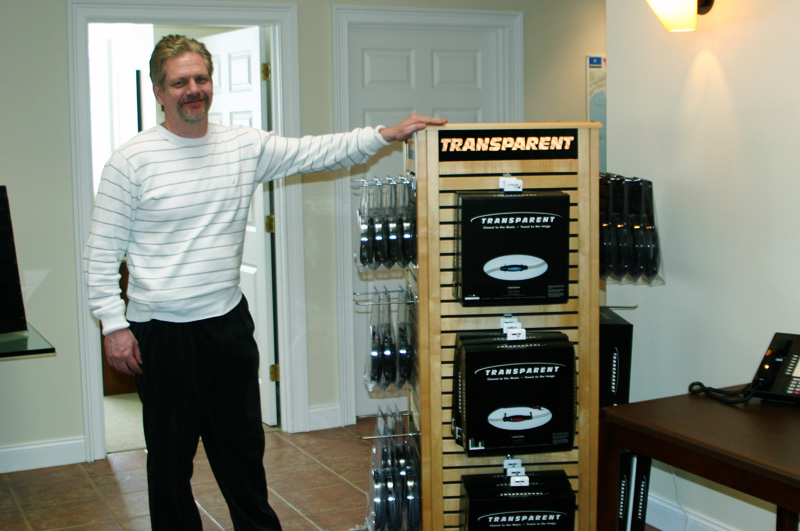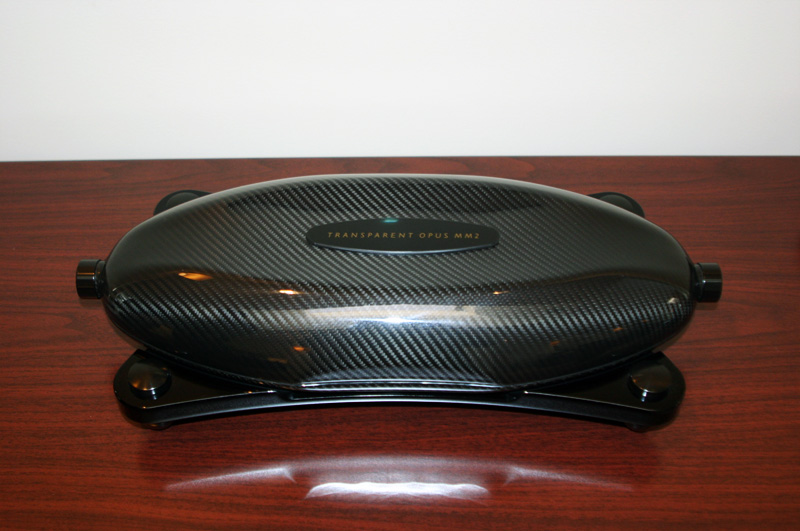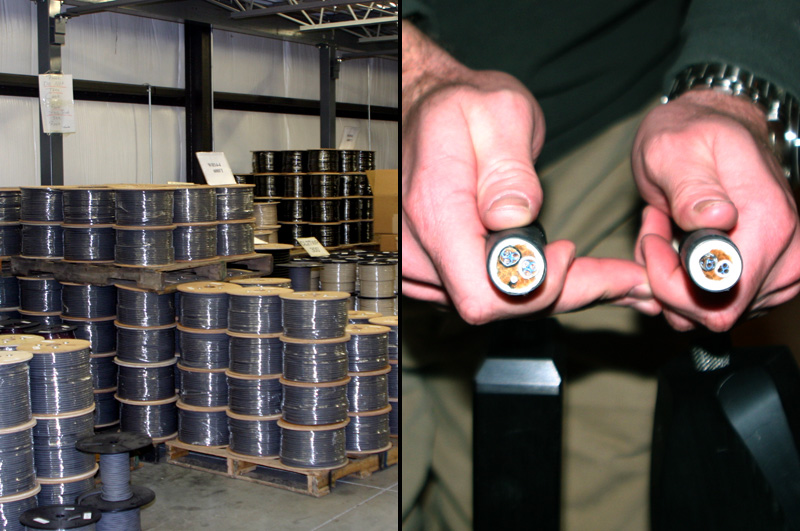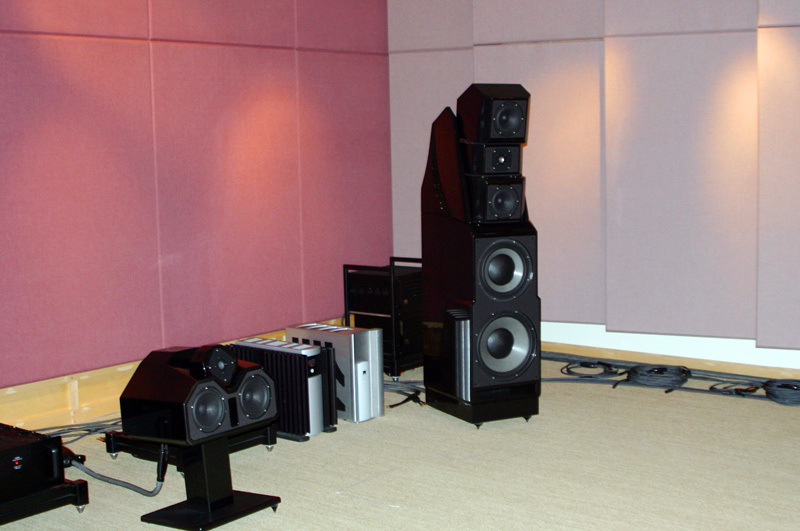| June 1, 2009
Searching for the Extreme: Transparent Audio
In late February, when Jeff Fritz and I traveled from North
Carolina to pick up a couple of pairs of speakers from Rockport Technologies, in Rockport,
Maine, we decided we’d also visit some other audio destinations before making our way
back home. One obvious stop was Transparent Audio, whose factory is just south of
Portland, Maine. Our contact there was Josh Clark, whom I’d met a few years before,
when arranging to audition some Transparent cables. Right off the bat, I’d found
Clark easy to communicate with. Not only is he very knowledgeable about Transparent’s
product line, he’s also an accomplished musician and, above all, a music lover.
Clark offered to pick us up at the airport and drive us to
the truck-rental office. After a surprisingly stress-free flight, we stepped out of the
warm terminal of the Portland International Airport and into a bitterly cold Maine day.
With a few inches of snow on the ground and the temperature at 15 degrees, the conditions
were quite different from the North Carolina weather we’re used to. Clark was sitting
in his car in the parking lot, waiting for us.
Greeting Josh Clark in person was as comfortable as my
first phone conversation had been a few years earlier. On the way to pick up our 18’
box truck, we spoke about our smooth flights, as well as a little personal information
about our families. After picking up the truck, we followed Clark to the Transparent
factory, in Saco. The facility was built in 1998, and was extensively renovated just last
year.

Transparent Audio’s facility in Saco, Maine.
We carefully navigated the icy parking lot and sidewalk,
and finally made it into Transparent’s large, open lobby. There, Clark asked everyone
in the building to introduce themselves, one at a time. In all, we met about ten different
people, who worked in departments ranging from sales to quality control; each told us his
or her name and a little about what they do at Transparent. Two things struck us: most
Transparent employees have been with the company for more than several years, and each has
several job descriptions -- Amy Farwell, for instance, who’s worked for Transparent
since 1997. We met Farwell in the parking lot, as she prepared to go to the store to buy
drinks for our lunch. The company’s inventory manager, she also helped redesign its
website, answers the phone, coordinates all the orders for Transparent’s foreign
distributors, and occasionally handles a sales call. (No outside salespeople represent
Transparent; they do it all in-house.)

Brad O’Toole is proud of Transparent Audio’s sales display, which they
supply to their dealers.
Farwell’s mother and father, Betty and Ralph Hamm,
have worked for Transparent since 1985. They’re what Clark calls terminators, or
product-assembly technicians. However, no terminator works at the Transparent facility;
each has a home workshop, and almost every one is a musician or artist of some sort. The
flexibility of being able to work at home, on their own schedule, allows them to live
their passion while holding down a steady job. And in Transparent’s experience,
artists are usually cleaner, neater solderers.
At the beginning of each week, terminators stop by to pick
up the materials they’ll need to fulfill the list of current orders. At the end of
the week, they deliver to the Transparent office the finished products, for which
they’re paid by the piece. If a customer returns a pair of cables for being
defective, the terminator who built it is held responsible, and may see a difference in
next week’s check. The longer you work for Transparent, the further up the product
line you move. Ralph and Betty now assemble the Reference, Opus, and PowerIsolator
products.
Transparent builds custom orders for their dealers in an
in-house laboratory. If a customer needs a speaker cable with certain connectors, in an
odd length, or specified to work with certain equipment, Lisa Terroni, Tim Wilson or
Rebekah Libby build it to specification.

The aluminum boxes of yesteryear have been replaced with more advanced materials.
None of Transparent’s three founders were present the
day we toured the facility. However, as Clark walked us through their offices, he
described the contribution of each. Karen Sumner is the visionary of the company,
providing direction in terms of product development, packaging, and promotion. Her
husband, Jack Sumner, is the head of design and engineering. Both are accomplished
musicians.
The third founder is Carl Smith, a former attorney, who
left the law to pursue his love of music and audio. During our visit to his office, Clark
showed us a book Smith had written about Bud Powell, one of the two most important bop
pianists: Bouncing with Bud: All the Recordings of Bud Powell, with a foreword by
Chick Corea (Biddle Publishing, 1997). He also pointed out a CD that Smith had had a hand
in bringing to the public: a collection of live recordings by Sonny Rollins, one of the
most respected tenor saxophonists in jazz. Smith coproduced this CD with Rollins and it
was released in 2008. After all these introductions, I had the strong feeling that the
Transparent family was filled with people who have real passions for music.
Clark then methodically walked us through the Transparent
warehouse. Orders are boxed on the ground floor, then shipped to one of 132 dealers and
distributors around the world. (Transparent keeps on hand $3 million worth of product to
make sure that they can serve their dealers as soon as possible.) On the upper level are
stored stocks of parts for each level of cable. There Clark pointed out component parts of
different cables and explained the purpose of each. He also explained how much each cost
to design, to produce as a prototype, and to manufacture. When a particular model of cable
goes into production, a certain quantity of parts must be purchased at a time. All of
these factors contribute to how much Transparent ultimately charges for that model.
 |
| Transparent’s
raw cable on spools. |
The cable
on the right is the newest incarnation of Transparent’s cable geometry; to the left
is the old. |
Perhaps the most important part of a
Transparent cable is the signature feature of the company’s products: the network.
This module houses a passive low-pass filter that, Transparent claims, removes frequencies
well above the upper limit of human hearing. Once this is done, Transparent says, the
cable can then more accurately transmit the remainder of the signal -- the part that falls
within the audioband -- and reproduce with greater fidelity the lower frequencies, among
other things. After the network is built, it is epoxied into its housing and connected to
the cable. The higher the price of a Transparent cable, the tighter the tolerances of the
component parts that make up its network.
Clark then told us about the new MM2 upgrades Transparent
introduced into their entire line of audio cables in 2008. They made extensive
improvements to their filter networks and completely redesigned the connectors on their
Reference-level cables. One of the changes they made was to remove the metal housing that
covers the solder joint between the wire and the spade or banana plug, replacing it with
an acrylic housing. This is done because the metal of the housing seemed to introduce
interference to the signal. With the new housing, the "graininess and glare" is
now gone, said Clark. Clark told us that, before the MM2 upgrade, he’d never thought any
cable could reproduce the natural sound of a brass instrument.

Transparent Audio terminators doing what they do best.
Clark then led us downstairs to Transparent’s
world-renowned listening room, where the company tests their cables in various setups to
detect any differences in the sound, good or bad. We were to be given a listening session
-- Clark wanted us to hear the differences between Transparent’s entry-level and
upper-level speaker cables and interconnects. The speakers were a pair of Wilson Audio
Specialties Alexandria X-2 Series IIs, and a pair of B&W bookshelf speakers. The
electronics comprised a Who’s Who of high-end audio names, including a
high-current amplifier from Mark Levinson and a hybrid tube amplifier from Lamm.
Clark began the demo by describing why each musical
selection had been chosen and what to listen for. Clark played the first track a couple of
times, then stopped the music. Then he, David Schultz and Rich Curole rushed behind the
speakers and quickly swapped out cables. That completed, Clark played the track all the
way through again, then put the player in Pause, and we discussed the differences. By the
time this cycle had been repeated for each track, Jeff and I were able to distinguish
individual improvements. In one instance, on a live recording, a female singer’s
voice had sounded a bit masked through the Ultra MM cables. With the switch to the new MM2
version of the Reference cables, her voice sounded more natural, with more clarity.
Clark then swapped out cables again, this time for a
comparison of the Reference and Opus lines, the latter Transparent’s top line of
speaker cables and interconnects. One 8’ pair of Opus speaker cables costs a
mind-boggling $33,000. Again, we heard the same sorts of improvements. With the Opuses
hooked up, there were definite improvements: Live music had a touch more life, and the
bass felt more detailed, even more dynamic. The soundstage seemed to deepen, and to spread
beyond the speakers’ outer boundaries.

Transparent Audio’s listening room features Wilson Audio Specialties speakers
and many brands of high-end electronics.
As we wrapped up our eight-hour visit, five of us sat in
the comfortable chairs of the large listening room and simply talked about music. Before
the session ended, Clark let me experience their home-theater setup, consisting entirely
of Wilson Audio speakers. Of course, the Alexandria X-2s were up front, a WATCH center
handled the dialogue, a pair of MAXX Series IIs were used as rears, and holding down the
fort in a rear corner of the room was an XS subwoofer. I’d never seen an XS in the
flesh. Jeff’s wife had told me about the time an XS had arrived at their home, and
the trouble they had getting the beast into the house.
Also part of Transparent’s home-theater rig was a
Meridian 800 and 861 Reference DVD player and audio processor. The demo scene Clark chose
was one I would have picked: "One Hundred Yard Dash," from Pixar’s The
Incredibles. It was the single best home-theater demo I’ve ever heard. The
Wilsons played big and loud, and the XS sub provided the tightest, deepest home-theater
bass I had ever heard. Definitely worth the price of admission.

The Transparent Audio family.
What a great day. Jeff and I had hoped to hit the road to
Rockport around 4:30 p.m., but now it was closer to 7. We didn’t relish driving the
three-plus hours to Rockport in the snow -- especially in an 18’ truck -- but we
didn’t regret the time we’d spent with the people at Transparent. While everyone
had their own job to do that day, whether promoting the company or teaching us more about
the science and art of making speaker cables, I can’t help feeling we made some new
friends. The folks at Transparent Audio are, first and foremost, music lovers. They
believe that their science, combined with their execution of it, allow their cables to
reproduce recorded music in the home in a way that other cables simply cannot. What a great
mission to have.
. . . Randall Smith
randalls@ultraaudio.com
|